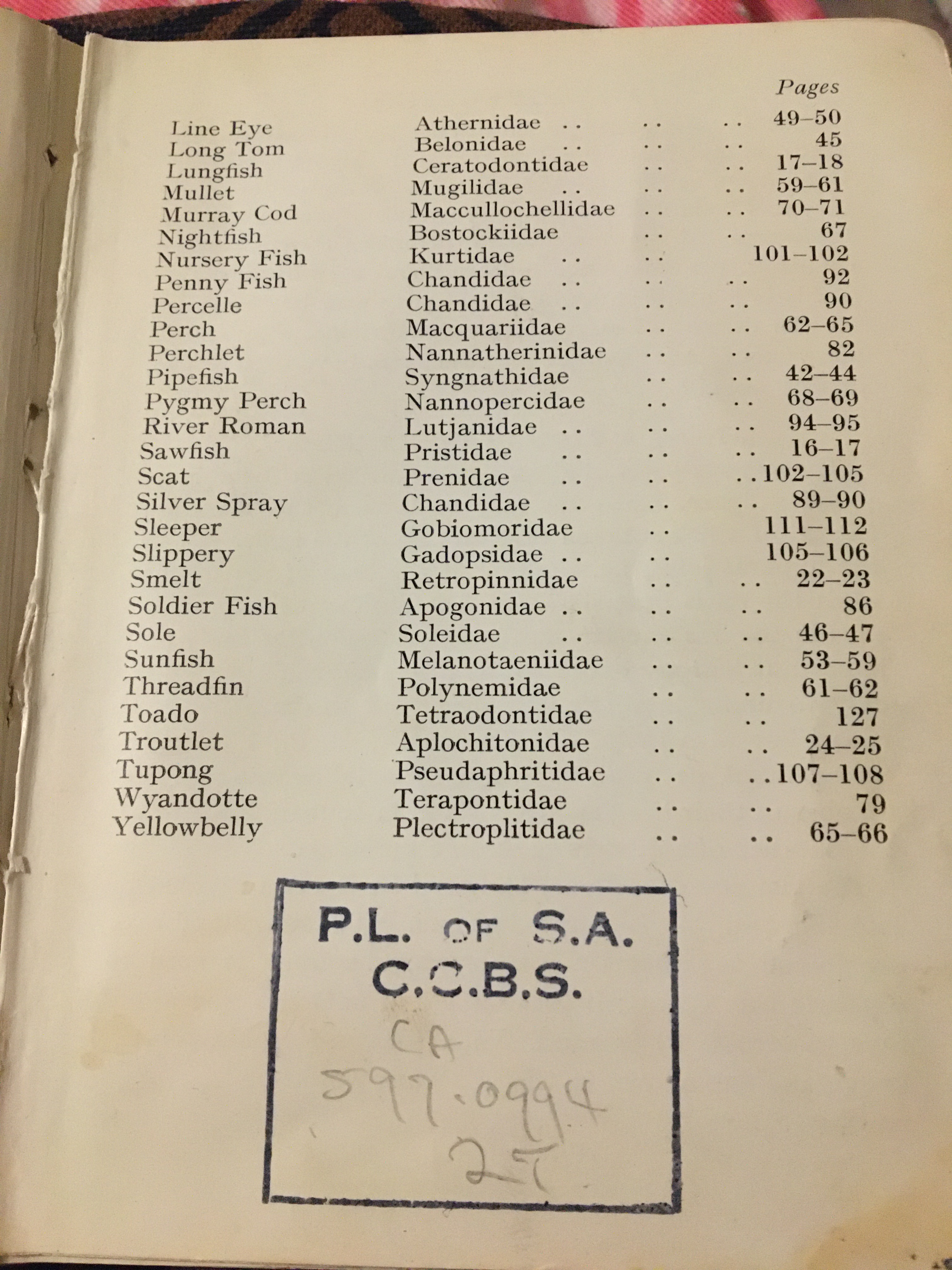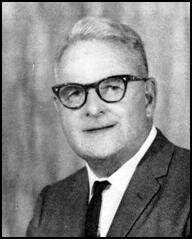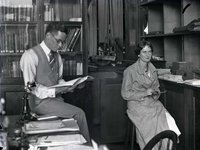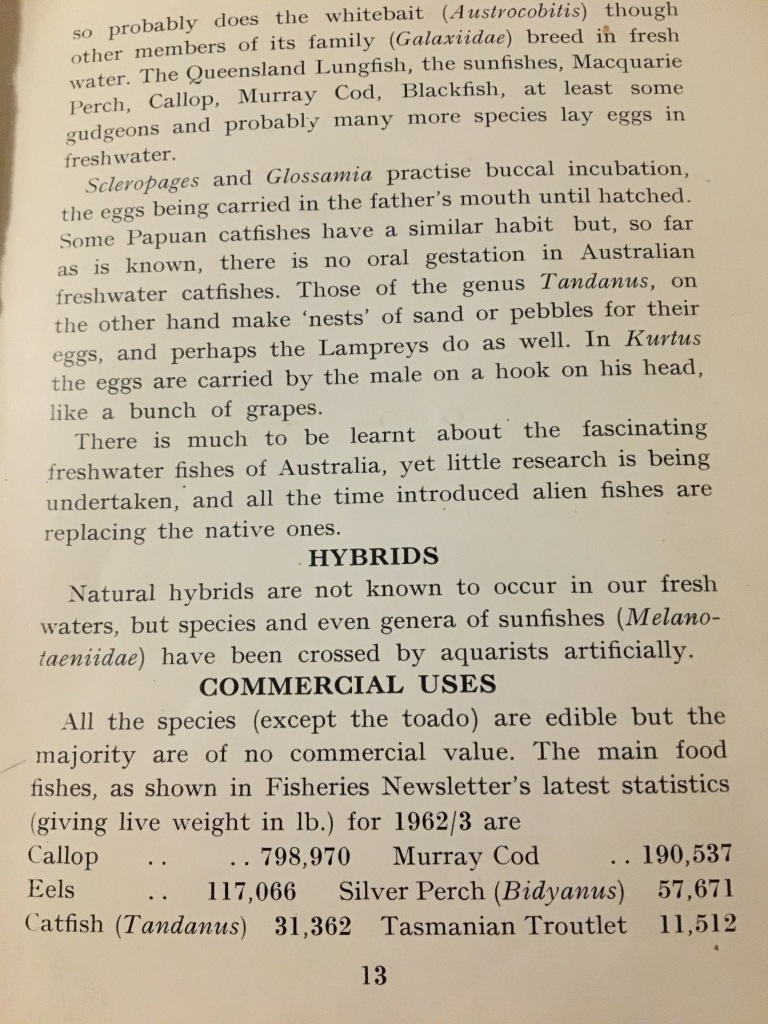I have been mildly obsessed this week with a little book that has sat on my shelves unnoticed for decades. I’ve been going through a bit of a reorganisation and getting rid of some of the very many books that are here. This one was in the give away pile – and most likely will be again – until I actually looked at it last weekend. It’s got the unprepossessing title “Native Freshwater Fishes of Australia” by Gilbert P Whitley. I would have got it at a library book sale back in the ’80s I think – chosen no doubt for its quirkiness – because it was so unlikely.


There are a few things about it that intrigue me a bit.
It is a children’s book – it was in the children’s library – it’s got a stamp for the P.L. of S.A. C.C.B.S. This stands for the Public Libraries of South Australia Country Children’s Book Service. It seems very serious and plain as a book for kids now. There are pictures, but all black and white, and there’s a lot of technical information too. I can see that the ‘collecting’ idea would be appealing to children – but really, not much else. There is a list of notes regarding the library’s processes inside the front cover – some of them are priceless. I love number 4 particularly (see below) which seems particularly relevant to those country kids.




Another mystery is that there is no publication date, but there are a few clues in the book itself. It’s got a pencilled price of $1.45 inside the front cover – indicating that it was on sale after Feb 1966, but I think I can see a faint trace of another pencilled price, in shillings and pence ?/6 – ‘something (can’t see) and 6’ – so maybe 1965/66. Then, within the book, in the section on page 13 ‘commercial uses of fish’ (see what I mean about it being a bit on the dry and unappealing side for children), it makes mention of the ‘Fisheries Newsletter’s latest statistics… for 1962/3’ – so there’s another big clue.
Another odd thing is that the call number of the book is professionally printed on the spine, in the same print as the book’s name – I think the whole thing has been bound for the library (the way journals and other books used to be until very recently – online journals make that unviable now) – perhaps to make it sturdier and more hard-wearing, in hopeful anticipation of hordes of youngsters borrowing it and reading it avidly, maybe taking it with them to their local creek to do a bit of fish identification.
My final bit of sleuthing re this little tome relates to Gilbert P Whitley, the author. He seems to have been quite a guy. The P stands for Percy. He was born in England in 1903 and came to Australia in 1921 with his parents and younger sisters. He started work at the Australian Museum in Sydney in 1922 (ie the year he turned 19), in the fish department, and became the museum’s ichthyologist after the previous guy, his boss, died in 1925 (ie when he was 22). He continued working at the museum for his whole working life, and kept up his commitment to fish and science after his retirement, until he died in 1975. The book includes details of many fish that he was the first to describe (in a scientific way I mean) – apparently he identified hundreds of different kinds of fish over his lifetime. There are at least two fish which have been named after him by others (I’ve put pics of them below). He wrote around 550 articles and numerous books. He was truly obsessed with his work. He also, it seems, was quite a character. He wrote humourous poetry and was witty and easy to get along with. There is an excerpt from a letter he wrote online (see below) which does make him seem endearingly engaged and amusing. It was written in 1935, to his colleagues (whom he addresses as “Dear People”), when he was away at a conference in Melbourne. That sense of the reality of his life, as he was living it, comes through. It seems splendid and very fortunate for him, that he fell into work that he obviously adored and made a mark in.
One thing I haven’t written about is the content of the book, for the obvious reason that I haven’t read it, or not all of it. I have included a few pages in this post though, and you will note that they have a mixture of really detailed technical information (eg some species of catfish practice “buccal incubation” – the eggs are carried in the father’s mouth until they hatch – who knew?), historical information (eg about Mitchell ‘discovering’ a species of catfish with the help of an Aboriginal ‘guide’), and a nod in the direction of conservation (in the Introduction – see above). The book’s illustrator is not named – maybe it was Whitley himself, if the fish below, drawn by him, is anything to go by.







I’ve gone on in possibly boring detail here, because all these different angles on this humble object help to make a time (the 1960s and earlier) and place (Australia, and particularly South Australia), and particularly Gilbert himself, a bit more alive to me. The order and structure of the library system. Those country kids getting boxes of books sent up through that system regularly, to read and return. The respect accorded to books – they were really cared for. All the people who were part of this process – packing the books and sending them, checking them out and in, the drivers, the librarians, the kids themselves; the binders – who were they? What did they think of their work and this weird little book? Percy himself – gregarious, hard working, massively committed. By the time this book appeared, he’d been travelling around doing field trips for 40 years. He was an old hand, well respected, at the end of his working life. And now this little book as a reminder of it all, a remnant that has lain dormant in my shelves all this time. An object that is plain, strange, real, and also a bit unreal – like life itself.



And then there’s the topic of Jacaranda Pocket Guides! Which would have opened up the whole story of Australian publishing in the 1960’s. You missed that one! Or maybe you just didn’t put it in this blog? No wonder the clearing is such a slow process my friend. Just the right way to do it. I hope you’ll give them to to some old bookseller (seller of old books) for others to enjoy.
Well, yes, Nicky. Jacaranda will have to wait for another post! I have been giving books so far to Rotary book exchange. They sell what they can and the books that won’t sell get turned into kitty litter, so no waste really. Love to you my dear.
Sent from my iPhone
>